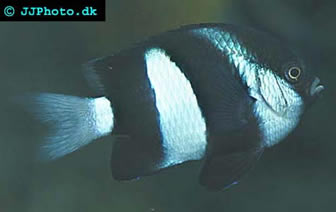Striped Damsel
Dascyllus aruanus is known under many different common names in English, such as Striped Damsel, Striped Damselfish, Black and white Damselfish, Threestripe Damselfish, White tailed Damsel, White-tailed Damsel, White tailed Damsel, Banded Humbug, Common Humbug, Zebra Humbug, Humbug Damselfish, Humbug Dascyllus, White-tiled Footballer, and Whitetail Dascyllus.
Dascyllus aruanus has not been evaluated for the IUCN Red List of Threatened Species.
Geographical range, habitat and habits
The Striped Damsel inhabits the Indo-West Pacific and its geographical range stretches from East African and the Red Sea to the Line, Marquesan and Tuamoto islands. The northernmost specimens are found off the southern coast of Japan, while the range proceeds southwards down to Sidney, Australia.
Striped Damsels are typically found in close vicinity of branching stony coral heads in shallow lagoons and subtidal reef flats. It is known to occur in large aggregations over staghorn Acropora thickets as well as in smaller groups over individual coral heads. The depth range for Striped Damsel is 0-20 meters / 0-65 feet. It is a day-active species that will seek shelter during the night. Juveniles will often live together with sea anemones but they seem to lose this ability as they mature into adult fish.
Size and appearance
The largest scientifically measured Striped Damsel was 10.0 cm / 3.9 in.
The Striped Damsel is white and adorned with three black bars. A large brown spot is located on the dorsal part of the snout. The pelvic fins are black, the caudal fin is pale, and the pectoral fins are translucent.
Striped Damsel care
The Striped Damsel is easy to care for and can be recommended for novice marine aquarists. It will however become territorial as it matures, so be prepared to deal with this. Many aquarists use Striped Damsels to cycle their aquarium, but you should keep in mind that being added as the first fish to an aquarium will amplify the territorial behaviour of this species. In most cases, it will claim the entire aquarium as its own territory and try to chase away other fish from it. You can prevent this by adding the Striped Damsel as the last fish to the aquarium or by carrying out a major redecoration of the aquarium when you wish to new add fish. It is always important to decorate the aquarium in a way that makes it possible for the Striped Damsel to claim only a part of it as its territory, i.e. to create natural borders in the tank.
It is important to include good hiding spots in the aquarium; for the Striped Damsel as well as for the other inhabitants. Ideally provide each Striped Damsel with its own rock cave or coral head.
Young Striped Damsel specimens will typically stay near a good hiding spot most of the time, while older specimens are bolder.
The recommended water temperature is 24-28° C / 75-82° F. Keep the pH-value within the 8.1-8.4 range and the specific gravity at 1.020-1.025.
The Striped Damsel is sometimes kept alone. If you don’t wish to add any other fish to the aquarium, a 10 gallon / 40 litre tank is large enough.
Feeding Striped Damsel
In the wild, the omnivore Striped Damsel feeds chiefly on algae, benthic invertebrates and zooplankton. It is known to accept a wide range of foods in the aquarium, including dry food. Keep you fish an a varied omnivore diet that contains both green and meaty foods. You can for instance use high-quality flakes or pellets as a base and supplement with plenty of live, fresh or frozen meaty foods and algae/algae-based food. Vegetables will also be beneficial. It is important to keep the food small enough for the fish to devour, e.g. finely chopped shrimps and fish fillets. Feed your Striped Damsel several small servings throughout the day instead of just one or two large portions. If you keep your fish in a prolific reef aquarium you can cut down on the feeding a bit because the fish will hunt for prey on its own.
Breeding Striped Damsel
Striped Damsels can be sexed based on outer appearance. The male fish is typically somewhat bigger than the female, but not always. A safer method of sexing is therefore to look at the genital area. The male fish is equipped with a tube that ends in a tip, while the female have a wide and crate-like tube.
During breeding, the males will entice females to lay eggs in their nests, typically in the substrate near some type of cover. The males will then fertilize the eggs and protect them until they hatch. A male fish may mate with several females. While tending to eggs, the male fish will be extremely aggressive. The eggs are ready to hatch after 3-5 days. The pelagic larvae feed on plankton.
The Striped Damsel has been successfully bred by hobby aquarists.
Damsel Species Articles
Green Chromis aka Black-axil Chromis
Blue Green Chromis
Blue Devil
Blue Velvet Damsel
Yellowtail Damsel
Fiji Blue Devil
Blacktail Damsel
Domino Damsel
Clownfish Articles
Black Clownfish - Information about Black clown fish
Breeding Clownfish - A very brief describtion on how to breed clownfish
Cinnamon Clownfish - Information about Cinnamon Clownfish
Clarkii Clownfish - Information about Clarkii Clownfish
Maroon Clownfish - Information about Maroon Clownfish
Ocellaris Clownfish - Information about Ocellaris Clownfish
Percula Clownfish - An article about how to keep and breed Percula breeding.
Pink Skunk Clownfish - Information about Pink Skunk Clownfish
Saddleback Clownfish - Information about Saddleback Clownfish
Tomato Clownfish - An in deepth article about tomato clownfish.

